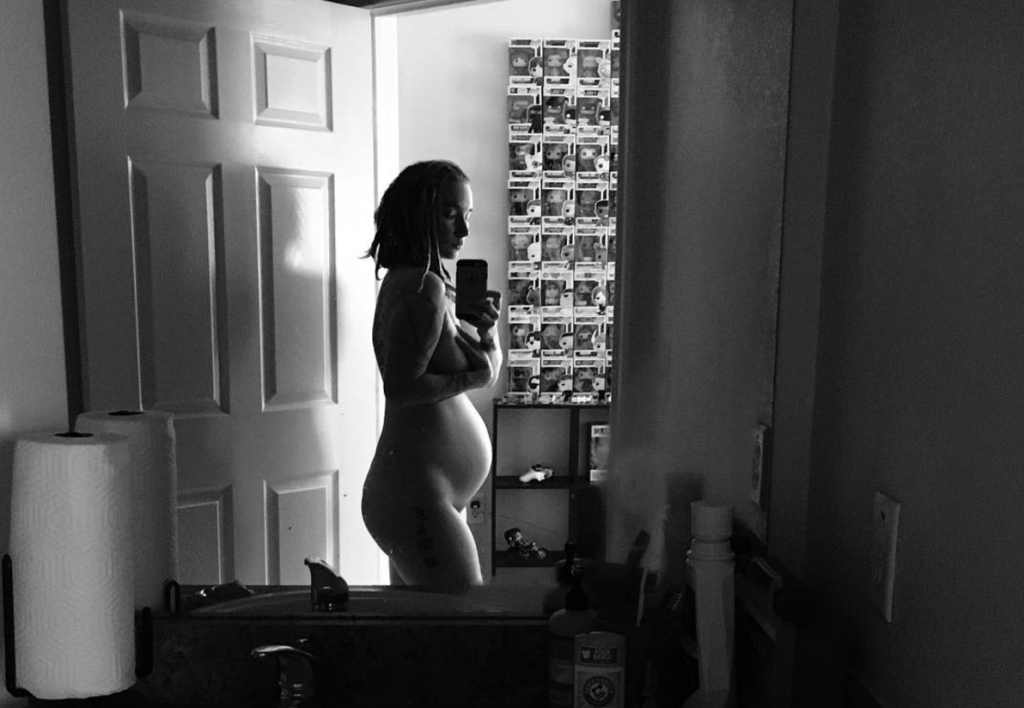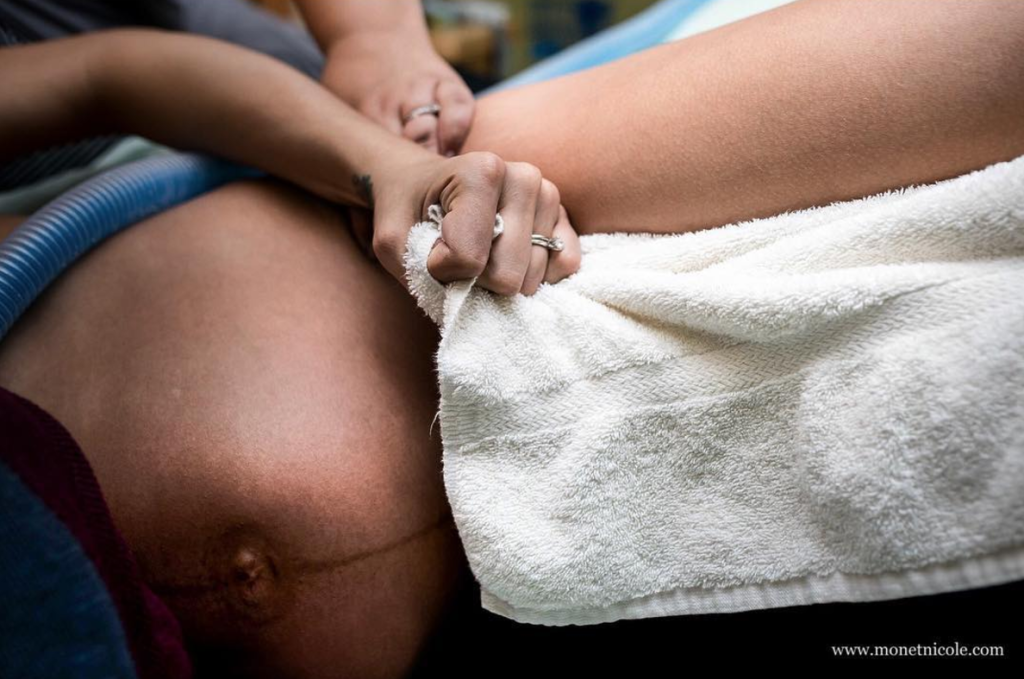You are now entering most people’s favorite trimester! This is sometimes called the “honeymoon period” of pregnancy and for good reason. Your morning sickness will likely be subsiding soon (or already has), your energy is coming back, and you are starting to feel like your old self again. That little “food baby belly” is now starting to grow a bit bigger and look like a real pregnant bump! There’s lots to look forward to this trimester, and a few potential discomforts. Here’s what you can expect.
Exciting Happenings
Quickening: This is one of the best parts of being pregnant—when you start to feel your baby move! This can happen anywhere from about 16-22 weeks depending on where your placenta is positioned. At first it feels like slight flutters or “butterflies” in your tummy. As baby grows you’ll start to feel more distinct kicks and jabs. You might even notice slight rhythmic “taps” from time to time. That’s the baby hiccuping!
20 Week Ultrasound and Anatomy Scan
This is the big ultrasound where the doctor checks out the baby’s entire body and organ systems—even down to four tiny chambers of the heart. It’s so fascinating to see all the tiny little organs already formed and functioning. The best part? You can find out baby’s gender, if you wish. That’s when the real fun begins. You can plan a gender reveal party, and get shopping for some cute baby clothes and gear!!
Pregnancy Hair changes
A big bonus from pregnancy hormones is great hair. It may appear thicker, shinier or have textural changes. Normally, we lose about 100 strands of hair per day, but the increased progesterone levels during pregnancy slows down the process so less falls out. Hair can feel much fuller, and appear shinier too! After birth, things normalize, and many women report losing large amounts of hair, so enjoy the luxurious locks while you have them!

Continuing Breast Changes
Soreness and tenderness should be subsiding during this phase, as your body is adjusting to being pregnant. Breasts may continue to grow in size, so another shopping trip may be in order.
Increased vaginal discharge
You may start to notice an increase in clear or milky-white substances when you use the bathroom or in your underwear. Increased estrogen and blood flow to the vaginal area are at play here, as the cervix and vagina slough off old cells. This is completely normal, and not cause for concern unless you have any of the following signs.
Signs of Concern with vaginal discharge
- Itching or burning associated with urination or sex, or a swollen vulva (this could indicate a yeast infection).
- Greyish discharge with a foul, fishy smell (signs of bacterial vaginosis).
- Green or yellow discharge associated with swelling, redness, or itchiness (could be a sexually transmitted infection).
Preventing bacterial infections
Keep your vaginal area clean by washing regularly, wiping from front to back when going to the bathroom, and wearing breathable (cotton) loose fitting underwear (no thongs!). Avoid scented soaps, lotions, and bubble baths.
Vivid Pregnancy Dreams
This is an interesting side-effect of pregnancy. Experts aren’t clear on the exact reason pregnant women have more vivid dreams but it might have to do with the increased hormone levels again. There are many changes happening in your brain, and our emotional, mental, and physical selves are all woven together.
It could also be due to changes in sleep patterns. REM (rapid eye movement) sleep occurs when your body is in a very deep sleep state. This is when dreams usually occur. Restless sleep, and frequent awakening for trips to the bathroom can interrupt this REM sleep, thus the dreams are remembered clearly. Dreams can range from bizarre, anxiety-based, and intense, to sweet little predictions of your baby to come. Keeping a pregnancy journal near the bed can be a fun way to record the things you dreamt about the baby before he or she comes!
Bleeding Gums
Good oral hygiene is especially important during pregnancy. Increased blood flow and hormonal changes can cause swollen, bleeding gums when you brush and floss. Watch for signs of gum disease (red, swollen, tender and bleeding gums, associated with pain and difficulty chewing).
Prevent Gum Disease
Make sure you take the proper precautions to preventing gum disease by:
- Brushing and flossing daily
- Scheduling regular dental cleanings
- Eating a balanced diet and keeping sweets to a minimum
- Brushing gently
Congestion/ nose bleeds
Increased blood flow to nasal capillaries can sometimes cause irritation, stuffiness and bleeding. Accompanied by an increase in mucus production, these nasal changes can prompt more nose-blowing, further irritating the area. Nose bleeds can occur as a result. This is not cause for alarm unless it is happening frequently and a substantial amount of blood is lost. If so, contact your doctor for treatment.
Treat nasal irritation
Provide nasal relief by using a warm-air humidifier while sleeping. This can keep passages moist and prevent dryness and cracking. Over the counter medications may also work to relieve congestion and mucus production. Make sure to check with your doctor first about what is safe.
Second Trimester Skin Changes
Hormones are at work again when it comes to skin changes. A potential effect is called the “mask of pregnancy,” or chloasma. This is a slight pigment darkening around cheeks and eyes. It can be exacerbated by sun exposure, so wearing a hat for protection or good sunscreen can prevent it from becoming too noticeable. Another skin change some women get is called the “linea nigra,” or the dark line that appears vertically down the belly. These skin changes will lighten or subside completely after birth when hormones return to normal.

Stretch marks are another common effect of pregnancy. These pink, purple, or brownish stripes can appear on breasts, hips, stomachs, buttocks and thighs as bodies change and grow. Some lotion and oil companies make claims to prevent these marks, but in reality, there is nothing to prevent them from occurring, although lotions can certainly be soothing with stretching skin. We recommend this Stretch Oil. Take heart as most marks fade significantly after pregnancy. Think of them as a badge of motherhood. The Fourth Trimester Bodies Project helps women to love and accept their bodies and all the post-baby changes and provides empowerment and support for moms everywhere.
Spider and varicose veins affect women differently, and seem to have a genetic component. Not all women end up getting them, but they can be uncomfortable and embarrassing. You can prevent them somewhat, or lessen the discomfort by taking frequent breaks from long periods of sitting. Ten minutes every hour is good. Likewise, take sit breaks from long periods of standing, or better yet take a little walk and get some blood flowing. Support hose also help keep circulation in good health. Cute compression sockss are a fun alternative to support hose that we’ve tried personally.
Heartburn during Pregnancy
Progesterone relaxes muscles in pregnancy. Unfortunately it can also relax the sphincter connecting the esophagus to the stomach, leaving small openings. Acids used to digest food in the stomach can back up through the gap and into the esophagus. It’s exacerbated by a growing belly that puts pressure on the digestive organs, resulting in painful heartburn.
Tips to combat heartburn
- Eat smaller meals frequently rather than 3 large ones.
- Eat slowly to aid in digestion and prevent overeating.
- Sip water throughout the day rather than gulping large amounts at a time.
- After meals, go for a walk, or sit up rather than lounging or reclining. Keep that esophagus upright.
- Avoid eating right before bed.
- Pay attention to which foods worsen your symptoms. Common triggers are citrus, chocolate, caffeine, and high-fat foods.
- Wear loose-fitting clothing.
- Use ginger—Drink ginger ale, ginger tea, or snack on raw ginger or ginger drops.
- Take antacids, but make sure they do not contain aluminum as it can cause constipation and high levels are bad for the baby.
- If all else fails, talk to your healthcare provider about prescription meds.
Back pain during the Second Trimester and Beyond
As your uterus grows, accompanied by weight gain and progesterone-relaxed muscles, increased strain is put on your lower back. Your lumbar spine also tends to sway in to compensate the displaced weight.

How to relieve lower back pain during pregnancy
- Wear good foot support. Put those heels aside for a while and lace up some comfy tennis shoes with arch support or flats. This aids in good posture, and puts way less strain on your back. These lightweight and supportive shoes saved my back through my pregnancy!
- Consider using a maternity support belt like this one.
- Use good body mechanics. When lifting things, bend with your knees and hinge at the hips, keeping your back straight. Then use your legs rather than your back to lift. Better yet, ask someone else to lift things for you!
- Try heat packs and ice packs. Experiment with which offers better relief. Ice tends to reduce inflammation, and heat can relax muscles further.
- Massage. Schedule a prenatal massage with someone who has experience with lower back pain. At the very least, this is great self-care for mama.
- Use a tens machine. Tens machines send little electrical pulses to the area of your body experiencing pain. like little electric shocks. This can help to ease pain in pregnancy and even labor. A Birth Hour mama talks about relying on hers heavily in her birth story. I use this one regularly and love it.
- Stay active. My physical therapist always says, when things hurt, our instinct is to hold still and not move. What we really need is movement, but the right kind of movement to encourage relief. Try a leisurely walk, do some gentle stretching, go for a swim. See which kinds of movements feel good.
- See a specialist. Seek a professional’s care who knows about pregnancy. A good physical therapist, chiropractor, or doctor can be the answer.
Increased frequency in urination while pregnant
Blood volume during pregnancy increases by about 50% during pregnancy, and hormones cause that blood to flow more quickly through the kidneys. Thus, frequent urination occurs. Couple that with a heavy uterus resting right on top of the bladder and your bathroom will be your new best friend. Continue to drink lots of fluids. It’s important to stay hydrated. This is just one of those things that has to be endured. Like many other pregnancy symptoms, this will subside shortly after birth.
Round ligament pain during the second trimester
Two round ligaments are located in the pelvis, and their job is to hold the uterus in place. In non-pregnant women they are short and thick. As a woman becomes pregnant, and her uterus grows, the ligaments thin out and stretch, similar to a taut rubber band. Sudden movements can make them to tighten suddenly, pull on nerves, and cause spasms that radiate from the abdomen and hips to the groin. These sharp pains can be alarming for moms. Keep calm and try to remember this is normal. It should only last several seconds to a few minutes and then subside. Pay attention to what triggers these spasms—coughing/sneezing, turning over in bed, standing up too fast, or certain physical activities. Try to move smoothly and slowly. Do gentle stretches, yoga, take warm baths, and rest on a regular basis.
These pains would be worrisome if they don’t subside after a few minutes, or if they are accompanied by fever, chills, bleeding, or difficulty walking.
Action items during the second trimester
Take advantage of this trimester, because most moms feel really good! Try to get a big chunk of baby stuff done before the tiresome third trimester sets in. Here’s some good things to check off your list.
Schedule your glucose screening (typically done at 24-28 weeks)
Your doctor will probably recommend this diabetes screening toward the end of the second trimester. You will have to drink a concentrated glucose drink and wait a period of time and then have blood drawn. It can be an important precaution for early detection of gestational diabetes. If you are planning a midwife attended birth she may forgo the glucose drink in favor of orange juice and certain foods but the concept is the same.
Start a regular kegel exercise routine to strengthen your pelvic floor muscles
The muscles you use to start and stop the flow of urine are your kegel muscles. Every time you go to the bathroom, take a few extra minutes to practice tightening these muscles, counting to ten, and then releasing. Build up to ten reps at a time several times a day. Not only will these muscles aid in the pushing phase of delivery, they are a good part of pelvic floor health after birth as well to help muscle tone return to normal.
Continue or start a gentle exercise program
Hopefully you’ve been active already, but if first trimester sickness made it difficult, or you just haven’t started, now is a good time to get moving. Be sure to check with your doctor if you have not had a consistent exercise routine before now. It’s not a good idea to take up a new sport, but the general rule is you may continue most exercises and activities you participated in before you were pregnant (as long as they are non-impact). Listen to your body. You might have to modify intensity and duration. Take frequent breaks, stay hydrated, and make sure you are breathing comfortably. The second trimester is a great time for brisk walks, swimming, aerobics classes, gentle strength training and yoga. Your belly isn’t too huge yet, and you’ve got some energy, so take advantage! Fitness during pregnancy not only helps during labor, it aids in recovery and helps you lose baby weight after.

Plan and take a babymoon
The second trimester is the best time to take a babymoon (a “last hurrah” trip with your significant other before your life changes drastically). Again, your belly is growing but not restricting, and your energy is up! Airlines can restrict air travel after about 35 weeks due to risk of preterm labor, so squeeze in a trip during the second trimester while you can.
Travel precautions during pregnancy
- Check the Zika virus updates and choose vacation spots that are considered “safe.” Cover arms and legs to protect against bug bites and maybe invest in a pregnancy-approved bug spray. Remember that Zika can be sexually transmitted, so make sure your partner takes proper precautions as well.
- If you are flying to your destination, keep your circulation going. Stand and walk every hour or so, do heel raises and calf flexes, and wear some support hose/socks.
Start your baby registry
Go to Amazon or to Babylist and start selecting items you’ll need for baby. Check this post for what you really need. (**link to post about baby essentials**)
Research child care options
If you plan on returning to work, review your company’s maternity leave policy. Factor out when you will be coming back, and start looking for child care options you feel good about. You might want a nanny, a daycare center or in-home child care. Ask around to friends and family that you trust and start visiting facilities to get a feel for what it would be like. This is a sensitive and emotional thing for mamas to do. Make sure you really do your research and talk to lots of references. This is your precious baby, and you want to feel very comfortable and confident that your child is very well cared for in your absence.
Still feeling anxious?
Get creative with your options. Would your employer allow you to work from home a few days a week? Is your partner’s schedule flexible where they can help share the childcare load? Perhaps your work would allow you to bring your baby for a month or two while she is still small. Do you have a friend who is also looking for a babysitter? Maybe you could do a swap. Is it an option to work part time for a while and help watch her baby while she works and vice versa? I’ve seen all of these options work well for me and my friends. Think outside the box and do what feels right inside.
Sign up for a childbirth education class
Your hospital or birthing center are great resources for finding a class but it’s also a good idea to look for an independent class that won’t be biased to the policies of the institution putting it on. The Birth Hour offers a comprehensive childbirth course called Know Your Options that you can learn more about here. Bring your partner with you and learn as much as you can. Start thinking about your birth plan, and make any adjustments you need to in regards to health care providers. The more educated you are, the better prepared you will be for your big day. Read books (here’s a good list!), and read and listen to all kinds of birth stories.The Birth Hour podcast is great for hearing a wide range of scenarios and outcomes. You might be planning a textbook natural delivery, but keep in mind that sometimes labors take an unexpected turn. It’s important to listen to/watch/read about c-sections, epidurals, and natural births so you know what to expect should those situations arise.
Welcome to the glorious second trimester! Prepare and enjoy is the name of the game!
This guest post was written by Austyn Smith.
No Comments yet!